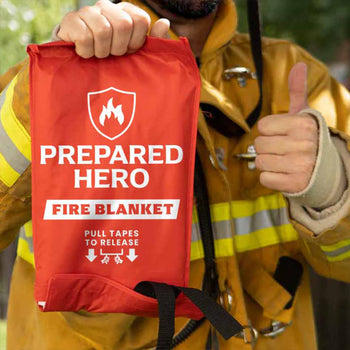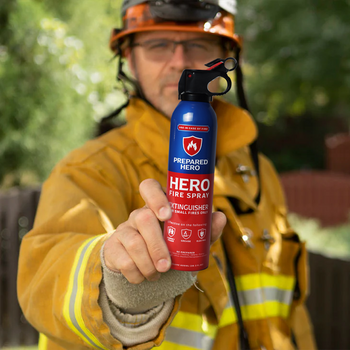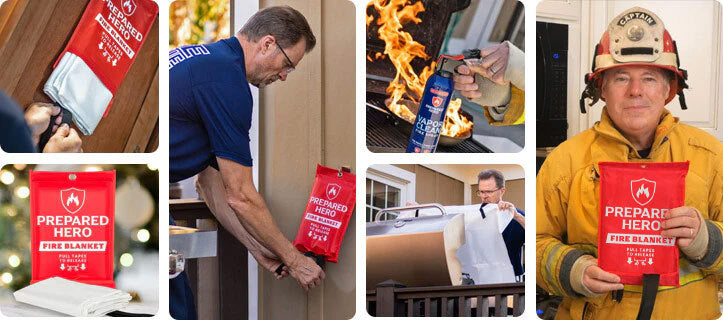Where you put your smoke detectors matters just as much as installing them. Proper placement makes sure they can detect...
A flashover, also known as rapid fire progress (RFP), is one of the most dangerous types of fire.
According to the National Fire Protection Association, flashovers and explosions are the second leading cause of fatal injuries to firefighters in the US. Plus, the rate of flashovers in modern houses is eight times faster than it was 50 years ago.
To help you and your loved ones stay safe, this guide explains how flashovers occur, how to spot one, and how to get out safely.
What Is a Flashover?

A flashover occurs when everything in a room ignites. It's like cooking popcorn: a few kernels gradually pop, but almost all of them burst open at the same time.
When a flashover occurs, the fire quickly escalates instead of burning slowly. In other words, the small flame becomes a roaring inferno.
In particular, a flashover occurs when most of the exposed materials in a room heat up to their autoignition temperature and produce flammable gases. According to the Federal Emergency Management Agency (FEMA), a flashover usually occurs at temperatures above 600°C (1,112°F).
Let's take a burning bed as an example to illustrate a flashover. The burning bed emits hot smoke, which spreads across the ceiling. The hot, buoyant smoke then grows because the bedroom walls bound it. The radiated heat from this layer heats the combustible materials in the bedroom, causing them to produce flammable gases. When the temperature of the gases becomes hot enough, things ignite.
Components of a Flashover

Like the fire triangle needs fuel, heat, and oxygen, a flashover needs components, too. Here are the components of a flashover:
Fuel
This refers to everything that can burn in a room. Think about your plush carpet, important files, and cozy bed. The more items there are, the bigger the flashover can be.
It’s not just the obvious things like wooden furniture or paper stacks. Softer items like cushions, curtains, clothes, and plastic containers can serve as fuel. Electronics, books, wall decor, and kids' toys will also burn once the heat is high enough. Basically, if it’s inside a room and can catch fire, it’s fuel.
Room Geometry
Heating a small room and a basketball court with the same amount of fire results in different scenarios. A small room will heat up much faster, especially if it doesn't have windows or vents.
When heat, smoke, and gases have nowhere to escape, they collect at the ceiling and quickly spread downward. The shape of the room, the ceiling height, and even how furniture is arranged all affect how heat and flames move. Low ceilings trap heat faster, and tight corners and narrow spaces can concentrate heat in one area. Basically, the smaller and more enclosed the space, the faster flashover can happen.
High Temperature
Fire loves to go upwards, which sends hot gases to the ceiling. As these gases heat the room, combustible materials produce flammable gases. Once everything reaches 600°C (1,112°F), a flashover can occur even with a tiny spark and hot air present.
At this point, the fire doesn’t need to touch anything directly. It ignites the gases in the air. This is why rooms can suddenly erupt in flames from wall to wall. You might not even see big flames before it happens. It’s all about the buildup of heat and gases. Once the temperature hits that range, things go bad fast.
Signs of a Flashover
A flashover is one of the most dangerous moments in a fire. It’s when everything in a room suddenly ignites at once. Knowing the signs can save your life or someone else’s. Here are the signs of a flashover:
Rolling Smoke
Thick smoke comes down from the ceiling, filling the room from bottom to top. At first, it might look like steam or fog, but it quickly turns black and heavy. If the smoke is dropping lower and moving fast, that’s a big red flag. It means heat is building, and things could flash over soon.
Scorching Heat
A sudden rise in temperature means an escalating fire and potential flashover. Imagine opening an oven door that has been heated up at least a hundred times. If you feel intense heat on your face or through your gear, even when you’re low to the ground, it’s a sign the fire is spreading fast. That kind of heat is dangerous.
Changing Flame Colors
Blue or clear flames turning to orange or yellow indicate a potential flashover. The shift in color shows that more fuel is burning, and the fire is feeding off the room’s contents. Yellow flames usually mean the fire is growing stronger and spreading wider. Pay attention to any color changes as they give clues about what’s coming next.
Dark Windows
Dark or smoke-stained windows indicate that the fire has produced significant smoke, which can result in a flashover. If the glass looks like it’s fogged up or covered in soot, that’s a clear warning. It means the fire inside is producing lots of smoke and heat, and it’s likely pushing toward a flashover stage.
Rolled-Over Flames
Flames that have rolled along your ceiling indicate that the gases are about to reach their ignition temperature. These are called flameovers or rollover flames. You’ll see them moving across the ceiling like waves. That means the upper layer of gases is getting super hot and could ignite the rest of the room at any second.
Cracking Sounds
Popping or thumping sounds indicate a coming explosion associated with a flashover. These sounds happen when materials inside the room are breaking down or when pressure builds up in the hot gases. If you hear cracks, bangs, or deep rumbling noises, don’t ignore them. It’s often a final warning before everything ignites at once.
How Hot Is a Flashover?

Flashovers get dangerously hot fast. FEMA says they usually start above 600°C (1,112°F), but they don’t stop there. During a flashover, the temperature in a room can hit 1,200°F (649°C) and sometimes spike over 2,300°F (1,260°C).
At this point, almost everything in the room (furniture, fabric, plastic) catches fire all at once. It marks a big shift in how the fire behaves, going from something growing to something totally out of control. The heat isn’t just intense, it’s deadly. That’s why firefighters are trained to spot early warning signs and get out fast if they think a flashover is about to happen. Those few seconds can make all the difference.
How Does a Flashover Occur?
A flashover happens when almost everything in a room catches fire at the same time. It starts with a small fire that grows and heats up the space. In a closed room, the heat rises and collects near the ceiling. As the temperature climbs, furniture, curtains, and other items start breaking down and releasing flammable gases. This process is called pyrolysis.
Once the air is full of these gases and everything is hot enough, the materials hit their ignition point. That’s when everything lights up in seconds. This is the flashover.
Certain factors make flashovers more likely. These include poor ventilation, low ceilings, and a lot of fuel in the room. All of these trap heat and speed up the process.
Some warning signs include intense heat, flames rolling across the ceiling, and smoke pushing lower to the floor. Flashovers are deadly because they cause fires to spread instantly and make it harder to escape.
What Causes a Flashover in a Fire?

Flashovers happen fast and without much warning. Knowing what causes them can help you stay alert and safe. Here are the causes of a flashover:
Heat Buildup
As a fire grows, it sends hot air and gases up to the ceiling. This heat has nowhere to go in an enclosed space, so it builds fast. The top of the room becomes extremely hot, even if the lower part still seems okay.
Pyrolysis
The rising heat starts breaking down nearby items, like couches, curtains, and cabinets. This process is called pyrolysis. As things heat up, they release flammable gases into the air, even before they catch fire.
Ignition of Gases
When the temperature gets high enough, gases and the surfaces of objects hit their ignition point. That means everything lights up almost instantly, even items that weren’t on fire before.
Rapid Transition
This moment starts the flashover. The fire jumps from being controllable to fully developed in seconds. Everything in the room burns at once.
How Fast Can a Flashover Occur?

A flashover can happen surprisingly fast. According to FEMA, it can happen as fast as three to five minutes after a fire starts. One big reason is how homes are built and furnished today. Many items, like couches and mattresses, are made with synthetic materials that burn hotter and faster than natural ones. Add in lithium-ion batteries from phones, e-bikes, or tools, and things get more dangerous. These batteries can go from smoke to explosion in just 15 seconds. Once heat builds up and flammable gases fill the room, a flashover can happen fast.
What Happens After a Flashover?
The fire gets fully developed and out of control after a flashover. Everything burns at once, and the heat goes past 600°C (1,112°F). That kind of heat weakens walls, floors, and ceilings fast. Structural collapse becomes a real threat. The fire also spreads quickly to nearby rooms, especially through open doors, vents, or cracks.
It’s hard to survive or fight the fire at this stage. Firefighters face thick smoke, zero visibility, and extreme heat. If they can’t cool the space right away, the fire will keep growing. Even their gear can start to break down.
Eventually, the fire starts dying as it runs low on fuel and oxygen. This cooling phase is called decay. But by then, the damage is already done. For this reason, recognizing flashover signs early and acting fast is crucial. Once it flashes, the window to stop it is gone.
How to Survive a Flashover

Surviving a flashover takes quick thinking, training, and staying calm under pressure. First, know the signs: fast-moving black smoke, intense heat, and a change in fire behavior. If you see these, act fast. Stay low to avoid the hottest air. Then, move quickly toward a known exit or backup egress point. Always communicate your conditions to your crew and command.
If escape isn’t possible, try to take cover behind a closed door to block the heat. Conserve your air and control your breathing. Keep your gear clean because dirty turnouts can ignite faster in extreme heat.
Most of all, prepare ahead of time. Train for flashovers, learn to read fire conditions, and be ready to cool the space or isolate the fire when possible. In a flashover, every second counts. What you do before and during makes all the difference.
Can a Firefighter Survive a Flashover?
Surviving a flashover is extremely challenging, even for experienced firefighters. If a flashover occurs, those present in the room have low chances of surviving. While survival is unlikely once a flashover has occurred, firefighters can increase their chances by recognizing early warning signs, such as rapid buildup of heat, rollover, and thick, dark smoke. Immediate action, including retreating to a safe area, can be life-saving.
Proper training, awareness of fire behavior, and adherence to safety protocols are crucial in preventing flashovers and enhancing firefighter safety.
What Is Flashover in Electrical Terms?

In electrical systems, a flashover happens when electricity jumps across an insulator or between conductors instead of following its normal path. This usually means the insulation failed. It can be caused by high voltage, dirty or wet insulators, overloads, or aging materials. When that happens, the current may spark or arc through the air, which can damage equipment, cut power, or hurt people nearby.
What Is the Difference Between a Flashover and Backdraft?
A flashover and backdraft are both dangerous fire events, but they’re not the same. A flashover happens when everything in a room gets so hot that it catches fire at once. It spreads fast and fills the space with flames.
On the other hand, a backdraft is an explosion. It happens when a fire uses up all the oxygen, then fresh air suddenly enters, like when someone opens a door or window. That oxygen feeds the fire and causes a blast.
A flashover is heat-driven and quick, while a backdraft is triggered by sudden air and is explosive. One spreads fire fast, the other blows up without warning.
How Do You Stop a Flashover?

Firefighters stop a flashover by cooling the area, limiting oxygen, and spotting warning signs early. The main goal is to bring down the heat fast. Spraying water on the fire, ceiling, and walls helps cool the space and stop hot gases from building up. They often use a fog pattern with quick bursts to reach high into the smoke layer. They also move with the hose and keep water flowing.
In addition, closing doors helps cut off oxygen, slowing the fire. Venting must be done carefully because too much air can make things worse. Plus, spotting signs like rising heat, smoke dropping lower, or small flames in the gas layer gives firefighters a heads-up. Experience and training play a big role in knowing how and when to respond.
Getting Out Safely
Evacuate your house immediately if you see any of the signs of a flashover. Fires that are about to become flashovers shouldn't be challenged. Prioritize your safety, get out quickly, and let the professionals handle the fire.
Conclusion
While we can't totally predict when a flashover will occur, knowing the warning signs keeps us safe. Having a fire kit with emergency fire blankets, fire sprays, and flame shields also helps. Check out Prepared Hero’s fire prevention tools here, and get up to 51% off on certain items. Stay prepared, hero!


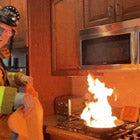 Fire
Fire Safety
Safety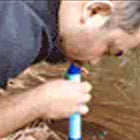 Survival
Survival Protection
Protection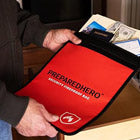 New
New Scouting America
Scouting America
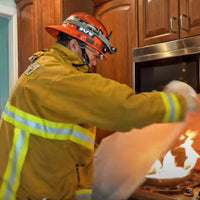 Fire
Fire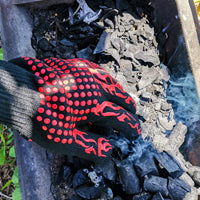 Safety
Safety Survival
Survival Protection
Protection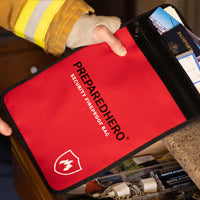 New
New
